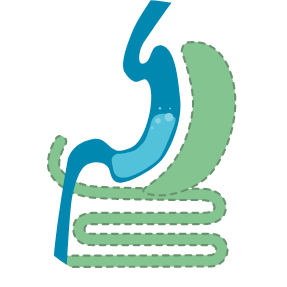
At Panhandle Weight Loss Center in Amarillo, Texas, our bariatric surgeons offer a range of weight loss surgery procedures so that we can customize each patient’s treatment according to their unique needs and goals. In addition to traditional Duodenal Switch surgery, we also offer Loop Duodenal Switch surgery, a variation on the original procedure that may be better suited for certain patients.
What is Duodenal Switch Surgery?
Duodenal Switch weight loss surgery, formally known as Biliopancreatic Diversion with Duodenal Switch (BPD-DS), is a two-step laparoscopic procedure. During the first phase of the procedure, a surgeon removes a portion of the stomach in the same manner as a Gastric Sleeve procedure. Next, the surgeon reroutes a portion of the small intestine called the duodenum through the lower intestine.
There are three mechanisms by which Duodenal Switch surgery helps patients lose weight:
- This procedure is restrictive, which means that it limits the amount of food a patient is able to eat.
- This procedure is also malabsorptive, which means that it changes the way the body absorbs calories.
Duodenal Switch surgery also affects the production of the hunger hormone ghrelin, which helps patients manage cravings.
Benefits of Duodenal Switch Surgery
Duodenal Switch surgery is more complex than other bariatric procedures such as Gastric Sleeve, but it also produces rapid weight loss and is an ideal option for many of our patients who are severely obese and suffer from comorbidities such as Type 2 Diabetes and sleep apnea. Some of the many benefits of Duodenal Switch include:
Greater Weight Loss
Duodenal Switch surgery can help patients lose more pounds more quickly than other bariatric surgery procedures, including Gastric Bypass surgery and Gastric Sleeve.1 Many patients lose 80-90% of their excess weight.2
Effective Treatment of Type 2 Diabetes
Duodenal Switch is the most effective bariatric surgery procedure for treating Type 2 Diabetes.3 Diabetes remission is achieved in more than 90% of patients who undergo this weight loss surgery procedure.4
Improved Sleep Apnea
After Duodenal Switch surgery, up to 90% of patients are able to safely stop using their CPAP machines.5
Improved Asthma
Following Duodenal Switch, up to 88% of patients are able to decrease their asthma medication.6
Improved High Cholesterol
More than 70% of patients see improvements in their cholesterol levels after Duodenal Switch.7
Improved High Blood Pressure
Up to 79% of patients see improved high blood pressure.8
Reduced Risk of Dumping Syndrome
The risk for dumping syndrome is much lower with patients who undergo Duodenal Switch than in patients who undergo Roux-en Y Gastric bypass.9
Loop Duodenal Switch Surgery
Some of our patients may be good candidates for a variation of Duodenal Switch surgery called Loop Duodenal Switch (Single Anastomosis Duodenal-Ileal Bypass with Sleeve Gastrectomy or SADI-S). As with a traditional Duodenal Switch procedure, the Loop Duodenal Switch involves dividing the duodenum and rerouting it to the lower intestine. However, with Loop Duodenal Switch, the intestine is rerouted at one connection point (anastomosis) rather than two.
Benefits of Loop Duodenal Switch
Because only one anastomosis is formed during Loop Duodenal Switch, this laparoscopic procedure requires less time in the operating room and is associated with fewer complications. Additionally, since more of the small intestine is maintained during the Loop Duodenal Switch, patients often encounter fewer issues with vitamin deficiency and diarrhea.
Comparison of Duodenal Switch Procedures
| Duodenal Switch (BPD-DS) | Loop Duodenal Switch (SADI-S) | |
| Description | – Reduces the size of the stomach by ⅔ – Reroutes a portion of the small intestine | – Reduces the size of the stomach by ⅔ – Reroutes a portion of the small intestine |
| Anastomosis | 2 | 1 |
| Advantages | – Rapid Weight Loss – Effective Treatment of Type 2 Diabetes – Improved Sleep Apnea – Improved Asthma – Improved High Cholesterol – Improved High Blood Pressure – Reduced Risk of Dumping Syndrome | – Rapid Weight Loss – Effective Treatment of Type 2 Diabetes – Improved Sleep Apnea – Improved Asthma – Improved High Cholesterol – Improved High Blood Pressure – Reduced Risk of Dumping Syndrome – Shorter surgery time – Lower risk of vitamin deficiency – Lower risk of diarrhea – Lower risk of anatomy leaks |
| Disadvantages | – May cause vitamin deficiencies, malnutrition – May cause discomfort – Stomach may stretch with excess food intake – Patients will need to take vitamins and supplements in perpetuity – Two Anastomosis – Longer surgery time – Higher risk of complications – Higher incidence of diarrhea – Higher risk of anastomotic leaks | – May cause vitamin deficiencies, malnutrition – May cause discomfort – Stomach may stretch with excess food intake – Patients will need to take vitamins and supplements in perpetuity |
| Recovery | Required overnight stay | Home same day |
| Time Off Work | 1-2 weeks | 1 week or less |
| Complete Recovery | 3 weeks | 3 weeks |
| Time Off Work | 1 Week | 1-2 Weeks |
Preparing for Duodenal Switch Surgery
The key to feeling well-prepared for your Duodenal Switch procedure is to attend a private consultation with one of our experienced bariatric surgeons. Here, you will learn more about your weight loss surgery options and find out whether Duodenal Switch is the right procedure for you. If you are a good candidate for bariatric surgery, the team at Panhandle Weight Loss Center will help you prepare for this step in your weight loss journey. Once your procedure is scheduled, we will give you dietary instructions and other guidelines to follow before surgery as well as detailed information about what you can expect during the recovery period.

The Duodenal Switch Procedure
A laparoscopic Duodenal Switch procedure generally takes between 1 and 1.5 hours and patients can either go home the same day or stay overnight in the hospital.
There are two main steps to the Duodenal Switch procedure. The first stage is identical to a Gastric Sleeve procedure, where the surgeon uses a special stapling device to remove up to 80% of the stomach and creates a narrow sleeve from the remaining portion. This part of the surgery allows patients to feel fuller after eating significantly less food.
During the second part of the Duodenal Switch procedure, the surgeon changes the natural path of digestion by rerouting food from the upper part of the small intestine. To accomplish this, two incisions are made in the small intestine, one below the duodenum and another towards the lower end of the small intestine. The lower cut end is then brought up to the higher cut end, allowing food to bypass much of the small intestine. This second stage of Duodenal Switch surgery reduces the number of calories a patient’s body is able to absorb. It also releases endogenous hormones which raises a patient’s metabolism and reverses insulin resistance.
Duodenal Switch Recovery
Following Duodenal Switch weight loss surgery, patients can expect to be up and walking shortly after the procedure. Some postoperative pain can be anticipated, but this should be tolerable and pain medication will significantly enhance patient comfort. Patients are cautioned not to do any heavy lifting (more than 10 pounds) for at least 3 weeks after Duodenal Switch surgery, and should refrain from strenuous exercise for at least 3 weeks. The majority of patients are able to return to work roughly 1 week after weight loss surgery.
Duodenal Switch Follow-Up and Aftercare
After Duodenal Switch surgery, patients who adhere to our postsurgical and follow-up care regimen have better chances of long-term success. Two weeks after surgery, patients meet with their Physician Extender, who will monitor their healing, identify any potential complications, and make adjustments to their medications. Over the course of their weight loss journey, patients should continue to work with their Physician Extender as well as a health coach, dietitian, and psychologist as needed.
For more detailed information about what to expect before, during, and after Duodenal Switch surgery, please consult our Bariatric Surgery Manual.
Frequently Asked Questions About Duodenal Switch Surgery
Who is a candidate for Duodenal Switch surgery?
If you have struggled to achieve and maintain a healthy body weight with diet and exercise alone, you may be a good candidate for a Duodenal Switch procedure. Duodenal Switch surgery is typically performed on patients who have a BMI (Body Mass Index) of 50 or higher and who need to lose at least 100 pounds. We perform metabolic testing on patients to help determine which surgery would fit them best. The Duodenal Switch surgery can be performed in patients with a lower BMI who have a lower metabolism or who have Type 2 Diabetes or insulin resistance. The best way to know whether this procedure is right for you is to attend a consultation with one of our bariatric surgeons.
Is Duodenal Switch surgery safe?
Duodenal Switch is a potentially life-saving surgical procedure. Any surgery is associated with some risks and complications, but working with an experienced bariatric surgeon you trust is the best way to achieve a favorable outcome. Your surgeon will fully educate you about concerns associated with Duodenal Switch surgery, which may include:
- Duodenal Switch is more complex than other weight loss surgery procedures
- Duodenal Switch is not fully reversible
- Patients may encounter vitamin and nutritional deficiencies including malnutrition after Duodenal Switch
- Patients often experience more frequent bowel movements after this procedure
Other risks and side effects associated with Duodenal Switch may include:
- Bleeding
- Infection
- Blood clots
- Small bowel obstruction
- Hernias
- Anastomotic leaks11
Does insurance cover Duodenal Switch?
For patients with obesity, Duodenal Switch is often considered to be medically necessary and thus eligible for coverage under most medical insurance policies. To learn whether bariatric surgery is covered under your plan, use our Free Insurance Check tool.
Can I afford Weight Loss surgery?
Some of our patients do not have medical insurance or their procedure is not covered under their plan. Other patients choose to bypass their medical insurance in the interest of expediting their weight loss surgery. Whatever the case, we believe that a healthier body and more fulfilling life should be within everyone’s reach. We can connect you with a number of healthcare financing sources to help you break the cost of your care into manageable payments.
Contact Us
If you have a BMI of 50 or higher and suffer from Type 2 Diabetes or other health problems related to obesity, you might be an ideal candidate for Duodenal Switch weight loss surgery. To learn more about your bariatric surgery options, please contact us at Panhandle Weight Loss Center in Amarillo, Texas.

Are You a Candidate for Our Weight Loss Programs?
Take our 60 Second Assessment
1 Johns Hopkins Medicine. BPD/DS Weight-Loss Surgery. Available: https://www.hopkinsmedicine.org/health/treatment-tests-and-therapies/bpdds-weightloss-surgery. Accessed July 7, 2023.
2 Annals of Surgery. Duodenal Switch Provides Superior Weight Loss in the Super-Obese (BMI ≥50kg/m2) Compared With Gastric Bypass. Available: https://www.ncbi.nlm.nih.gov/pmc/articles/PMC1856567/. Accessed July 5, 2023.
3 American Society for Metabolic and Bariatric Surgery. Bariatric Surgery Procedures. Available: https://asmbs.org/patients/bariatric-surgery-procedures#bpd. Accessed July 5, 2023.
4 Cleveland Clinic. BARIATRIC SURGERY MAY CURE TYPE 2 DIABETES IN SOME PATIENTS. Available at: https://my.clevelandclinic.org/ccf/media/files/Bariatric_Surgery/bariatric_surgery_cure_type2_diabetes.pdf. Accessed Sept 19, 2023.
5 Marceau P, Biron S, Hould FS, Lebel S, Marceau S, Lescelleur O, Biertho L, Simard S. Duodenal switch: long-term results. Obes Surg. 2007 Nov;17(11):1421-30. doi: 10.1007/s11695-008-9435-9. PMID: 18219767. Available: https://pubmed.ncbi.nlm.nih.gov/18219767/. Accessed July 5, 2023.
6 Marceau P, Biron S, Hould FS, Lebel S, Marceau S, Lescelleur O, Biertho L, Simard S. Duodenal switch: long-term results. Obes Surg. 2007 Nov;17(11):1421-30. doi: 10.1007/s11695-008-9435-9. PMID: 18219767. Available: https://pubmed.ncbi.nlm.nih.gov/18219767/. Accessed July 7, 2023.
7 Buchwald H, Avidor Y, Braunwald E, Jensen MD, Pories W, Fahrbach K, Schoelles K. Bariatric surgery: a systematic review and meta-analysis. JAMA. 2004 Oct 13;292(14):1724-37. doi: 10.1001/jama.292.14.1724. Erratum in: JAMA. 2005 Apr 13;293(14):1728. PMID: 15479938. Available: https://pubmed.ncbi.nlm.nih.gov/15479938/. Accessed July 5, 2023.
8 Buchwald H, Avidor Y, Braunwald E, Jensen MD, Pories W, Fahrbach K, Schoelles K. Bariatric surgery: a systematic review and meta-analysis. JAMA. 2004 Oct 13;292(14):1724-37. doi: 10.1001/jama.292.14.1724. Erratum in: JAMA. 2005 Apr 13;293(14):1728. PMID: 15479938. Available: https://pubmed.ncbi.nlm.nih.gov/15479938/. Accessed July 5, 2023.
9 Columbia Surgery. Duodenal Switch (PBD-DS). Available: https://columbiasurgery.org/conditions-and-treatments/duodenal-switch-bpd-ds. Accessed July 5, 2023.
10 Surve A, Cottam D, Sanchez-Pernaute A, Torres A, Roller J, Kwon Y, Mourot J, Schniederjan B, Neichoy B, Enochs P, Tyner M, Bruce J, Bovard S, Roslin M, Jawad M, Teixeira A, Srikanth M, Free J, Zaveri H, Pilati D, Bull J, Belnap L, Richards C, Medlin W, Moon R, Cottam A, Sabrudin S, Cottam S, Dhorepatil A. The incidence of complications associated with loop duodeno-ileostomy after single-anastomosis duodenal switch procedures among 1328 patients: a multicenter experience. Surg Obes Relat Dis. 2018 May;14(5):594-601. doi: 10.1016/j.soard.2018.01.020. Epub 2018 Feb 2. PMID: 29530597. Available: https://pubmed.ncbi.nlm.nih.gov/29530597/. Accessed July 5, 2023.
11 Cleveland Clinic. Duodenal Switch. Available: https://my.clevelandclinic.org/health/treatments/22725-duodenal-switch#risks–benefits. Accessed July 5, 2023.
The surgeons at Panhandle Weight Loss Center have either authored or reviewed and approved this content. Page Updated:
